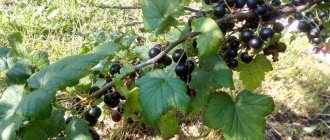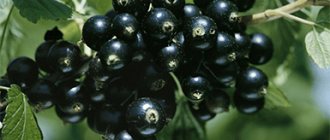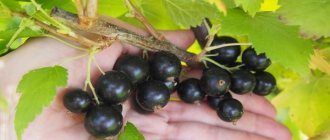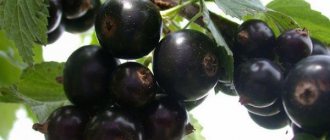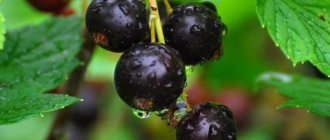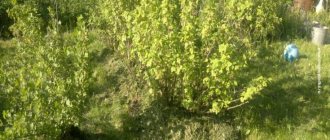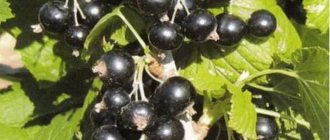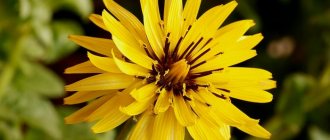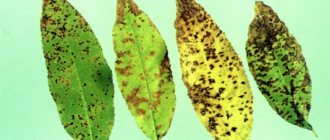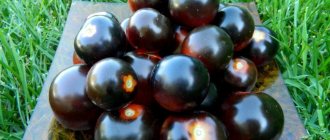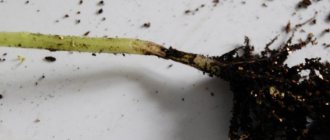Plant care
A plentiful and high-quality harvest in the future can only be obtained with proper care of the plant. Regular watering, weeding and timely prevention will prevent the occurrence of diseases and attacks by harmful insects. The black currant variety Bagheera, like any garden crop, despite its unpretentiousness, requires certain care.
Watering
It is very important to provide regular watering to the shrubs during the formation of ovaries and during the fruiting period. However, it is worth considering that currants do not like excessive stagnation of water.
In hot weather, it is preferable to water the plants using the sprinkling method, using 2-3 buckets for each bush. Watering should be done in the morning or evening 1-2 times a week.
Trimming
Blackcurrant pruning is carried out, firstly, to form a bush, secondly, to constantly renew the plant, thirdly, to prevent thickening and normalize the load of the crop
The formation of currant bushes does not occur immediately, but continues until the age of five. During planting, all shoots are shortened by 1/3. After the first pruning, 5–6 shoots are formed on the seedling, of which 3–4 (the strongest) are left, and the rest are cut off. This pruning procedure in order to form a bush is carried out for several years in a row. By the age of five, the bush consists of 3-4 branches each year.
During annual sanitary pruning, all dry and damaged areas are removed with sharp pruning shears to a healthy bud, as well as branches older than 4–5 years and those growing from the root collar.
Trimming rules - video
Top dressing
If the necessary fertilizers were added to the planting hole when planting the seedlings, no additional fertilizing is required in the first 2 years.
The first feeding is carried out in the spring. During the main digging, add 5 kg of compost or humus and 35–40 g of urea per bush. Similar fertilizing is carried out during the autumn digging period.
In April - May, fertilize with liquid fertilizer from mullein or bird droppings. To prepare it, you need to dilute 1 shovel of droppings in 10 liters of water and mix thoroughly. Each liter of the resulting infusion is diluted in a bucket of water and 2 buckets are poured under each bush into specially formed furrows.
The black currant variety Bagheera is frost-resistant. However, to be on the safe side before frost, you should tie the bushes and then cover them with film, paper or any other special covering material. Before this, it is advisable to water the bushes with 1-2 buckets of water using the sprinkling method.
Used fresh and processed
| Currant Bagira (lat. Ríbes nígrum Bagira) | |
| general characteristics | Spreading bush with erect stems |
| Ripening period | Mid-early |
| Taste | Sweet and sour with a little tartness |
| Fruit | up to 2 g |
| Fruiting | Average yield - from 1.6 to 2.4 kg per bush |
| Winter hardiness | High |
| Pests and diseases | High resistance to diseases and pests |
Currant Bagheera - photo, description of the variety:
- The mid-late currant variety Bagira (lat. Ríbes nígrum Bagira) was obtained by Michurin breeders by crossing the Bredtorp and Minai Shmyrev varieties. The bush is dense, with a medium spreading crown. The leaves are wrinkled, rich green, five-lobed. Young stems are light green, later covered with brown, woody bark. The buds are medium-sized, ovoid, solitary. The flowers are goblet-shaped, yellow-green, bisexual. The average brush length is 5-8 cm.
- Large berries, round, uniform, weighing up to 2 g. The skin is black, dense, resistant to cracking. The pulp is tender, juicy, with a large number of seeds. The taste is sweet and sour, rich. The aroma is pronounced currant.
- The variety is suitable for commercial cultivation. Good preservation of berries and transportability make the berries in demand on the market. The plant tolerates frost well and is demanding of moisture. With a long absence of sunny days, the yield of berries decreases. The variety also has poor resistance to powdery mildew and bud mite. Used fresh and processed.
- Planting is carried out in the spring before buds open and in the fall - in mid-September. The plant is not demanding on the composition of the soil, but to obtain a good harvest it is necessary to follow the rules of agricultural technology.
In the video, the author talks about Bagheera’s stable yield and ease of care. He also notes the high taste qualities of medium-sized berries:
Story
The culture was obtained at the Institute of Horticulture named after I.V. Michurin in the Tambov region, by crossing two varieties of currants. This is Bredtrop, whose homeland is Sweden and the Belarusian variety Minai Shmyrev. The authors of the variety were experienced professional breeders K.D. Sergeeva and T. S. Zvyagina. For almost 10 years, the plant underwent various tests, and in 1994 it was officially registered in the register.
The hybrid was bred with a recommendation for cultivation for the following regions of Russia: these are the Ural region, West Siberian, East Siberian, Volga-Vyatka, Middle Volga and North-West. Such a large number of regions, and therefore varied climatic conditions, are suitable for cultivating this variety, since the crop has good resistance to frosty winters, as well as hot, dry summers.
Currant Bagheera: planting and care
It is very rare for any plant to prefer light shading to bright sunlight, but currants will greatly benefit from a little shade, since there will be no sunburn.
Almost all plants love cereals, or at least intermediate soil quality, and black currants are no exception, but if the soil in your summer cottage is not so fertile, we advise you to fix everything before planting the bushes.
To do this, you need to pour a large bucket of humus, 300 grams of phosphate, 50 grams of potassium sulfite and a shovel of wood ash into a planting hole measuring 0.5m x 0.5m x 0.5m.
Next, you need to mix everything well and plant the seedling in our fertilized hole, but do not deepen it, then water it generously, mulch the soil and cut the seedling into a couple of buds.
After the job is done, all you have to do is take careful care and get the long-awaited results, but this will only happen if you did not skimp on planting material. If so, you can expect surprises, because in such a lottery it is quite difficult to get a worthy reward for your hard work.
Description of berries
Bagheera is a large-fruited currant variety, although it is not considered a record holder. One berry weighs on average 2-2.3 grams, which is a very good indicator. The shape of the berries is round, the sizes are equal. The skin has a rich black color, dense, but not hard. The berries come off dry when picked.
How to plant and grow an apple tree from a seed at home?
The pulp is very tender, juicy, the number of seeds is small. The taste is excellent, there is a pronounced aroma.
Bagheera berries are distinguished by high commercial characteristics; they are also valued for the fact that they ripen quickly and are suitable for transportation.
What is characteristic of the variety
Bagheera currant is self-fertile, but when planting mid-late varieties of the crop, its yield will increase significantly.
Botanical description of the bush
The planting grows up to 2 meters in height. Medium spreading bushes, densely leafy. Green smooth leaves remain on plants until frost. Flower brushes reach a length of 5-8 centimeters. They produce 4-7 black berries with a shiny surface.
Productivity and fruiting
The variety is positioned as a mid-late variety: berries weighing 2-2.5 grams ripen in mid-July. Currants bear fruit annually, the largest harvest is harvested in the 4th year, then the bushes require rejuvenation. The bush produces 3.5-4.5 kilograms of berries, which can hang on the branches for a long time without falling off.
Scope of application of fruits
Bagheera currants are used in industrial production and home canning. The berries are consumed fresh, compotes, juices, jams are prepared from them, and wine is also made from them. In addition, the fruits are frozen and dried for the winter.
Immunity to diseases
Bagheera currant has good immunity and is resistant to many diseases. But it can be affected by powdery mildew and anthracnose. To prevent diseases, you need to inspect the bushes, remove dry and diseased branches, thin out the crown, and remove plant debris from the tree trunk.
Frost and drought resistance
The variety is adapted for growing in difficult climatic conditions. It can withstand frosts down to -32°, as well as heat and prolonged absence of rain. Bagheera currant easily tolerates sudden changes in temperature and humidity.
Description and characteristics of the 25 best blackcurrant varieties for Siberia
Read
Description of the variety Bagheera
Bagheera is a medium-ripening blackcurrant variety. It has a spreading bush of medium height, from one and a half to two meters, leaves of medium color intensity, matte, have five blades, slow leafing is noticed - the bush goes into winter with leaves.
The variety is self-fertile, good because the berry is large, up to three grams, has approximately the same size, its color is not just black, but glossy black, which makes the berry even more attractive. The berries are collected in clusters from three to seven centimeters, with four to seven pieces per node, and there are usually two or three clusters in the nodes.
The yield of the Bagheera variety is good, up to five kilograms per bush, it enters the fruiting stage early, in the second or third year after planting. The peel has medium density and dry tear-off, which makes it possible not only to store the berries, but also to transport them without loss. its sweet taste and aroma for a long time and ripens smoothly.
The excellent taste of the berry seems to be created in order to make jam from it. Especially together with apples of summer varieties: Augusta, Hornist, Papirovka, Malinovka, Belyi Naliv.
Disease and pest control
Resistant to anthracnose and powdery mildew, Bagheera currant can be affected by rust. The crop is also dangerous for diseases such as terry blight and septoria.
Proper prevention and compliance with all agricultural techniques will help you avoid diseases, and this is much easier than treating them. Spring treatments with Bordeaux mixture (1%) - before the bushes bloom, copper sulfate, and Nitrafen are effective.
Treatment with a composition containing colloidal sulfur helps prevent terry. The same solution helps in the fight against the bud mite, which is dangerous for this variety of blackcurrant. The pest not only attacks currant buds, which reduces crop yields, but is also a carrier of diseases dangerous to currants - mosaic and terry. In addition to a suspension of colloidal sulfur, you can use chemical preparations - Vermitek, Apollo, strictly following the instructions for the compositions.
Pests such as glasswort and gall aphids cause great harm to currants. Against glassworm caterpillars that attack the buds and shoots of plants, use a 10% solution of karbofos (early spring, as well as after harvest), the drugs Fufanon, Iskra.
To destroy gall aphids, you will need the drugs Vofatox, Actellik and others, when working with which you must follow safety precautions.
Preventative measures against pests are:
- spraying currants with garlic infusion;
- regular pruning of bushes;
- removing weeds from rows;
- treating the bushes with an infusion of mustard powder (take 20 grams of dry mustard per liter of water, infuse it, dilute it with water to 10 liters and spray the currants);
- planting plants such as calendula, chamomile, and marigolds next to currants, which repel pests with their strong aroma.
Landing Features
The black currant variety Bagira is undemanding to soil composition and climate, therefore it is highly valued among summer residents. However, in order for the bushes to grow actively and bring good harvests in the future, it is worth working hard.
Dates and place of landing
Currant is a light-loving plant, but if you plant seedlings in an area in direct sunlight, there is a risk of burns. A little partial shade will not affect the quality of the harvest in any way, but at the same time it will protect the currants from troubles. You should also take care to protect the bushes from gusty winds. To do this, it is recommended to plant them along the wall of the house or fence.
The soil for planting is preferably light and fertile, without close proximity to groundwater and high acidity, with good drainage properties.
Selection of seedlings
The root system of the seedling should consist of 2–3 lignified main roots of a brownish-yellow color, at least 15 cm long, as well as many light thread-like roots
It is best to purchase seedlings from specialized nurseries that breed and grow various varieties of fruit and berry crops.
- The seedling must have a healthy root system, not damaged by diseases, without chips, cracks and dry or rotten areas.
- The shoots of the seedling should be light green, flexible and moist in a longitudinal section.
- When kneading, the kidneys should also be moist, without excessive crumbling.
Site preparation
3-4 weeks before planting black currants, it is necessary to thoroughly loosen the soil and remove remaining weeds, dry leaves and other debris. When digging, you should add 3-4 buckets of humus and 20-40 g of superphosphate and potassium sulfate per 1 m².
Step by step process
When using seedlings in containers, there are practically no restrictions on planting time
To ensure good growth and development of the seedling, it is necessary to adhere to the recommended sequence of planting the plant in the ground:
- Prepare planting holes measuring 40x40 and 35–45 cm deep with a distance of 1.2–1.5 m from each other and at least 1.7–2 m between rows.
- Add a mixture of fertile soil to each hole with the addition of 5–6 kg of humus, 15–20 g of potassium sulfate, 20–25 g of superphosphate and 350 g of wood ash.
- Thoroughly loosen the soil and pour in 3-4 buckets of water.
- After 5–7 days, the soil for planting is completely ready. You can plant black currants in the ground to a depth of 13–15 cm, carefully spreading the roots at the bottom of the hole.
- After planting, the soil is trampled down well, watered with 1–2 buckets of water and mulched with a mixture of peat and straw in a layer of 5–7 cm.
How to plant on the site
The hole for currants is dug 15-30 days before planting. Rotted manure and humus are added to it. In addition, you can add mineral fertilizers: 100 grams of superphosphate, 150 grams of ash, 20 grams of potassium sulfate.
Selection and preparation of a site
Currants prefer a sunny place, but shaded on a hot afternoon. For this reason, it is planted near fences, walls, and hedges. These structures will also protect plants from drafts. Groundwater should not approach the ground surface closer than 50 centimeters.
The place for planting Bagheera currants is cleared and dug up. The bushes will grow best on sandy or loamy soils with the addition of black soil.
The soil reaction should be neutral or slightly acidic.
Planting pit dimensions
In blackcurrant, the root system is located close to the surface of the soil, so the hole dug is shallow. It is dug up 15-30 days before planting the bushes. Hole dimensions: diameter – 50 centimeters, depth – 40 centimeters.
Timing and step-by-step instructions for planting work
Bagheera currants are planted in open ground in the spring before buds open or in the fall, when the leaves begin to fall. Planting is done as follows:
- The currant root system is placed in the prepared hole;
- water spills abundantly;
- the bush is covered with earth so that the root collar is buried no more than 10 centimeters.
Note! Currants can be planted directly or at an angle of 45°.
Seedling care
Currants will delight you with good harvests only with proper care. The bushes must be watered, pruned, and systematically fed in a timely manner.
Trimming
There are formative, sanitary and rejuvenating pruning.
After planting the seedling, the formation of the bush immediately begins. To do this, cut the shoot by ½ or 2/3 of the length.
Then, in the spring of the second year, all shoots are removed except for the 3 to 5 strongest ones. These will be the skeletal branches. In mid-summer, two buds are pinched on each of them. This will lead to the appearance of new shoots and fruit branches.
In the 3rd and 4th years after planting in the spring, the overgrown shoots are cut off, except for the 4th – 6th strongest ones. The tops of last year's branches are shortened.
This will lead to the formation of a strong bush in five years. It will have 3 – 4 shoots of different ages, each of which is younger than 5 years.
Sanitary pruning is the removal of diseased, dry and damaged branches. Usually it is carried out simultaneously with the formative one. In this case, the shoots are cut off near the soil itself.
Anti-aging pruning is needed for bushes older than 5 years. During this process, old branches and young but weak shoots are removed. Both cannot bear fruit, but weaken the plant.
Rejuvenating and sanitary pruning is recommended to be done in the spring. If it is carried out in the fall, then only after picking the berries.
Watering
Bagira and Shchedraya currants are watered 1-2 times a week, the frequency depends on weather conditions. After watering, the soil should be moistened by at least 40 cm. Usually this requires 4 - 5 buckets of water per m2 of land. It is better to do this in the evening, when the heat subsides.
It is especially important to carry out regular watering during the following periods:
- intensive growth of shoots (usually the end of May);
- change in color of berries (first ten days of July);
- laying buds for the future harvest (after harvesting the fruits).
If the autumn is dry, then watering should be carried out at the end of September.
Feeding
The first feeding of the plant is carried out during planting. Then it is repeated after two years and made regular.
The main fertilizers recommended for Bagheera currants are superphosphate, potassium sulfate, organic matter and urea.
After harvesting, superphosphate (50 g) and potassium sulfate (up to 20 g) are added to each bush. During this period, nitrogen fertilizers should not be used. They cause rapid growth of young shoots that will die from frost. Read about the best varieties of currants for Siberia at this link.
In early spring, urea is added to the soil. Young bushes - about 50 g. Over 5 years - 20 - 40 g. At the same time, older plants are fed with 2/3 of urea in early spring, the rest is added after flowering.
In summer, currants need organic matter (mullein or bird droppings). 5–10 kg of fertilizer is applied to each bush.
Shelter for the winter
Bagheera currant is a frost-resistant variety. But if desired, the bushes can be covered for the winter, especially if little snow is forecast.
The bushes are first watered by sprinkling and tied. Then they are covered with material that allows air to pass through well.
Harvest and storage
We recommend reading our other articles
- Mole Repeller
- How and what is the best way to feed melons in a greenhouse
- Violet Flower
- Strawberry Festival
Bagheera currant produces a large harvest already in the second year after planting. Flowering occurs in May, and the first berries ripen by the second ten days of July - early August. Fruiting is friendly. During picking, the berries are easily separated and do not burst. They are stored for a long time, maintaining their external and taste qualities. It is advisable to store the harvested crop in a cool, dry place. A refrigerator is also suitable, then the berries are placed in a plastic bag. Dry berries sent for storage on time retain commercial quality for up to 2 months, sometimes longer. The berries of the Bagheera variety can be consumed fresh, dried, frozen, used for cooking various dishes, juice, and canning.
Basic agricultural techniques
Many people believe that berry bushes do not require any special care. But in fact, you can get a large number of tasty and healthy berries only by providing the crop with regular watering, fertilizing, and pruning.
Watering
The Bagheera variety is drought-resistant, but it should not be brought to extreme situations. High-quality watering guarantees a decent result.
They take into account the weather, the amount of precipitation, as well as the condition of the plants themselves. Currants especially need watering during the following periods:
- growth of shoots in spring after wintering;
- the beginning of ripening of berries on the bushes (when the currant fruits have not yet begun to turn black);
- after harvest.
If there has been no rain for a long time in the fall, it is recommended to thoroughly water the currants at the end of September. Water under the bushes, avoiding the branches and leaves of the bush, moistening the soil well (up to half a meter). For 1 square meter you will need approximately 5-6 buckets of water.
Loosening the soil
The area with currant bushes must be cleared of weeds, and the soil between the bushes must be loosened. In the fall, after harvesting, it is recommended to carefully dig up the soil between the bushes every year, trying not to touch the currant roots.
Fertilizer application
Before planting young bushes, the soil is carefully filled with fertilizers. If you follow the norm, the supply of nutrients will last for two years. Next you will have to fertilize, for which they use:
- organic matter (poultry droppings, mullein);
- urea;
- superphosphate.
Organic matter is diluted with water; application time is late spring, summer. In early spring, urea is applied to currant bushes (for young plants - up to 40-50 grams per bush, for currants after five years - 20 grams).
After harvesting the berries, at the end of summer or autumn, the currants are fertilized with superphosphate (40-50 grams per bush).
IMPORTANT! Organics are not added to currants in the fall. Such fertilizers promote the growth of green mass and the growth of new shoots, which can be seriously damaged by cold weather.
Wintering
Bagheera is a very winter-hardy variety that overwinters well under snow until spring. Problems may arise in winters with little snow, as well as in regions where the amount of it in winter is small. It is necessary to prepare materials for shelter in advance (film, covering fabrics, paper), water the bushes, tie them up and cover them before winter.
Bush formation
Black currants need pruning, and this important procedure must be carried out correctly. Why trim shoots?
- To avoid bush thickening.
- To renew the plant.
- To normalize fruit load.
Every year, sanitary pruning is performed, when old shoots (4-5 years old), diseased, and damaged branches are removed. Using pruning shears, trim the shoots to full buds, removing all dried branches.
Also, in the first years after planting seedlings, bush formation is carried out. Ideally, by the age of 4-5 years, the bush should have 4-5 branches each year, so starting from planting, the shoots are first shortened, and then the excess and weak ones are removed every year. Usually pruning is done in the spring, but if there was too much work in the garden and garden, you can carry out the procedure in the fall.
For currants older than five years, rejuvenating pruning is carried out, during which old branches are removed. They are not suitable for fruiting, but they take away food, so they need to be pruned. Weak branches that do not have fruit buds are also pruned.
Seedling care
Currants will delight you with good harvests only with proper care. The bushes must be watered, pruned, and systematically fed in a timely manner.
Trimming
There are formative, sanitary and rejuvenating pruning.
After planting the seedling, the formation of the bush immediately begins. To do this, cut the shoot by ½ or 2/3 of the length.
Then, in the spring of the second year, all shoots are removed except for the 3 to 5 strongest ones. These will be the skeletal branches. In mid-summer, two buds are pinched on each of them. This will lead to the appearance of new shoots and fruit branches.
In the 3rd and 4th years after planting in the spring, the overgrown shoots are cut off, except for the 4th – 6th strongest ones. The tops of last year's branches are shortened.
This will lead to the formation of a strong bush in five years. It will have 3 – 4 shoots of different ages, each of which is younger than 5 years.
Sanitary pruning is the removal of diseased, dry and damaged branches. Usually it is carried out simultaneously with the formative one. In this case, the shoots are cut off near the soil itself.
Anti-aging pruning is needed for bushes older than 5 years. During this process, old branches and young but weak shoots are removed. Both cannot bear fruit, but weaken the plant.
Rejuvenating and sanitary pruning is recommended to be done in the spring. If it is carried out in the fall, then only after picking the berries.
Watering
Lack of timely watering leads to weakening of the currants, crushing of the berries and a decrease in their juiciness. Bagira and Shchedraya currants are watered 1-2 times a week, the frequency depends on weather conditions. After watering, the soil should be moistened by at least 40 cm. Usually this requires 4 - 5 buckets of water per m2 of land. It is better to do this in the evening, when the heat subsides.
It is especially important to carry out regular watering during the following periods:
- intensive growth of shoots (usually the end of May);
- change in color of berries (first ten days of July);
- laying buds for the future harvest (after harvesting the fruits).
If the autumn is dry, then watering should be carried out at the end of September.
Feeding
The first feeding of the plant is carried out during planting. Then it is repeated after two years and made regular.
The main fertilizers recommended for Bagheera currants are superphosphate, potassium sulfate, organic matter and urea.
After harvesting, superphosphate (50 g) and potassium sulfate (up to 20 g) are added to each bush. During this period, nitrogen fertilizers should not be used. They cause rapid growth of young shoots that will die from frost. Read about the best varieties of currants for Siberia at this link.
In early spring, urea is added to the soil. Young bushes - about 50 g. Over 5 years - 20 - 40 g. At the same time, older plants are fed with 2/3 of urea in early spring, the rest is added after flowering.
In summer, currants need organic matter (mullein or bird droppings). 5–10 kg of fertilizer is applied to each bush.
Shelter for the winter
Bagheera currant is a frost-resistant variety. But if desired, the bushes can be covered for the winter, especially if little snow is forecast.
The bushes are first watered by sprinkling and tied. Then they are covered with material that allows air to pass through well.
